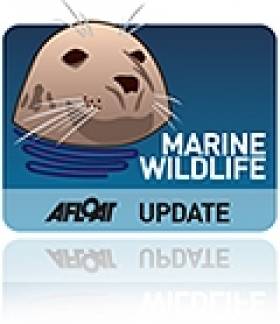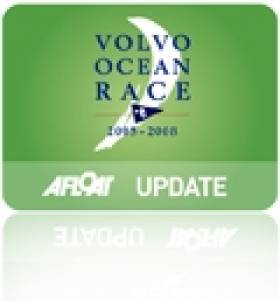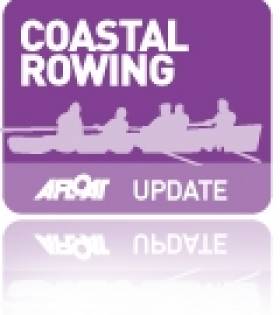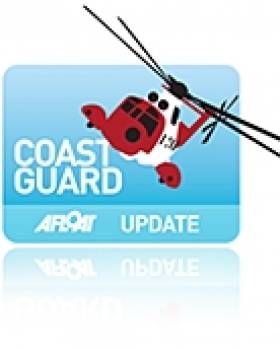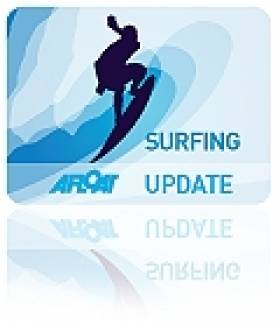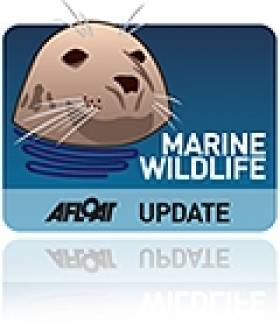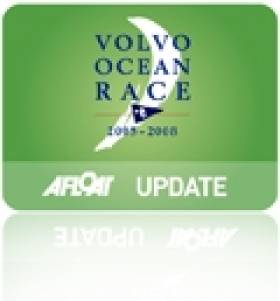Displaying items by tag: video
First Whales Of The Year Caught On Video
#MarineWildlife - Here's a little something cheerful to brighten up this chilly, snowy Monday morning: some video footage from YouTube shot by Irish Whale and Dolphin Group (IWDG) member Karl Grabe of the first whales to visit Ireland's shores in 2013.
As previously reported on Afloat.ie, the first sightings were made last week on the maiden member whale-watching trip on board the IWDG's new marine wildlife research vessel Celtic Mist off the coast of Wexford.
In addition to these fin whales, the group also made the acquaintance of a group of frolicking dolphins from the 'superpod' spotted in the Irish Sea recently, as you can see from the clip below:
Volvo Ocean Race Returns to Brazil for 2014-15
#VOR - Organisers of the Volvo Ocean Race have announced that the Brazilian state of Pernambuco will enter a team in the next edition of the round-the-world offshore challenge in 2014-15.
In addition, its capital city of Recife will be the first stopover port along the race route, which starts in Alicante in the second half of next year.
The Recife team is only the second publicly announced team for the 12th edition of the VOR, following the SCA all-women's team announced last August.
Details about the stopover and the team, including the identity of the skipper, will be announced in the coming weeks.
“[The] announcement of the Pernambuco team and Recife stopover are fantastic news for the race,” said Volvo Ocean Race CEO Knut Frostad. “I’m delighted to see the Race strengthen our ties with Brazil, Recife and Pernambuco in this way.
"Coming to Recife at the end of Leg 1 means there will be a lot of attention on this great city and having a Brazilian team in the race will be fantastic for fans across the country."
The decision to make Leg 1 of the route from Alicante to Recife means the VOR will be visiting Brazil in one of the biggest sporting eras in the nation's history – just a few months after the country hosts the 2014 Fifa World Cup and less than two years before the Olympic Games in Rio.
Recife was one of over 80 ports to express an interest in hosting the race when the bid process was launched in 2012. The deal announced yesterday will see Recife host the race for the next two editions.
The last Brazilian team to enter the Volvo Ocean Race was Brasil 1 in 2005-06. Torben Grael was the skipper and Knut Frostad, now the Volvo Ocean Race's CEO, featured as a crew member on some of the legs. The Brazilian campaign proved to be a big success and generated great interest worldwide and in the media. Grael went on to win the Volvo Ocean Race as skipper of Ericsson 4 in 2008-09.
The Volvo Ocean Race's links with Brazil date back to 1973, when the first edition of what was then known as the Whitbread Round the World Race stopped at Rio de Janeiro.
The race also visited Rio in the second edition in 1977-78 and again in 2001-02, 2005-06 and 2008-09. In 1997-98 the race stopped at São Sebastião and in the last edition in 2011-12, Itajaí was a host port.
Meanwhile, Team SCA have unveiled the livery for their VOR 65 new design when it is launched and ready to race later this year.
As previously reported on Afloat.ie, the new design VOR 65 - priced at €4.5 million, about 20% less expensive than the 70-footer that ended its run in Galway last summer - was developed with the idea of reducing the costs of competing in the gruelling round-the-world yacht race.
The official VOR website has images of the SCA livery, with nature-inspired graphics and colours designed to reflect the eco-friendly values of the title sponsor, global hygiene company SCA.
At the beginning of February, a number of Team SCA women crew candidates will leave Southampton on a first test sail together with several leading off-shore coaches.
Team SCA have not yet revealed the identity of any of the crew, including the skipper.
From Yacht To Flotsam In Just Five Minutes
#Sinking - How fast can a yacht sink? The video above shows just how swiftly one's dreams can disappear into the murky depths.
The clip, via Elaine Bunting's blog at Yachting World, captures the Sweden Yachts 45 Ciao in the waters north-east of the Cocos islands in the Indian Ocean last September as its rudder is damaged by impact with an object below the surface, quite possibly a whale.
Within the space of just five minutes, the fully functioning vessel is reduced to flotsam, its crew Srecko and Olga Pust escaped to their liferaft for rescue at the last possible moment despite their valiant efforts to save the yacht.
"The boat had been their home for several years while cruising, and they were to lose almost everything in the sinking," said Bunting.
Flatpack Coastal Rowing Skiff Is All The Rage
#CoastalRowing - News comes from Scotland of an intriguing new coastal rowing craze that sounds like something from a Swedish furniture store!
As the Guardian reports, a traditional Scottish fishing skiff design provided the inspiration for the new flatpack coastal rowing boat, which began life as a prototype project for the Scottish Fisheries Museum four years ago.
Since then the St Ayles skiff concept swept like a wave across the UK and beyond - and examples of the DIY kit row boat, which is handmade in Fife, can be found as far afield as Australia.
Many of those international rowers are expected to converge in Scotland this simmer for the coastal rowing world championships off Ullapool.
The Guardian has much more on the story HERE.
Sligo Sea Shanty Festival Returns For Fourth Year
#MaritimeFestivals - Running for the last three years, Sligo Bay RNLI is once again preparing for the Sea Shanty Festival in Rosses Point later this summer, with all proceeds going to the lifeboat station.
"The festival is a celebration of the long maritime tradition of Rosses Point and the Sligo area," as festival committee chair Willie Murphy explained last year.
"Shanties were working songs used on board sailing ships. The songs were mostly sung when the job involved several crew members working in rhythm together."
One of the many groups that have performed in the past is The Drunken Sailors from Germany, who have written a song inviting people back to Sligo Bay for the 2013 festival from 14-16 June.
The group’s story goes that back in the summer of 2012, the Drunken Sailor Shantymen were infected by the ‘Sligo Bay Virus’, and they asked their witch-doctor what medicine would help.
"You were infected by a well-known serious music virus out of the north-west of Ireland," they were told. "And the only think what may help, is to sing a song which tells a story of Sligo Bay.
"But take the medicine without any alcohol or other drugs, sing a great song for all friends of shanty music and you will get better!"
With this advice, the brave Drunken Sailor Shantymen started to sing the song you can hear in the video above, and which they think may move all famous artists to come back to Rosses Point Sea Shanty Festival later this year.
Howth Coast Guard Reviews A Busy 2012
#Coastguard - Howth Coast Guard responded to 53 calls throughout 2012, with its 25 volunteers clocking up more than 4,000 man hours.
In its review of the year, the north Dublin unit of the Irish Coast Guard noted that while its safety boat Grainne was dispatched to fewer calls on the water, there was an increased number of cliff and beach incidents to attend to, particularly in the Clontarf and Dollymount areas.
Howth also became one of the first search and rescue teams in the State to avail of the Irish Coast Guard's new side scan sonar.
As previously reported on Afloat.ie, the coastguard saved 161 lives throughout a busy 2012 that saw the network respond to almost 2,000 call-outs nationwide.
And 2013 so far has been off to a busy start, marked by a dramatic cliffside rescue in Donegal on New Year's Day.
Cold Water Surfers Catch The Waves At Brandon Bay
#Surfing - Check out this beautifully shot video from ONITmedia of intrepid winter surfers catching the breaks at Brandon Bay, Co Kerry.
The waves might not be the biggest that Ireland has to offer at this time of year - for those the wet-suited warriors head to Mullaghmore - but the stunning scenery, not to mention the surprise appearances by local cetaceans, more than make up for it.
Dolphins Make a Noise in the Shannon Estuary
#Dolphin - YouTube user Karl Grabe from Cork has uploaded this wonderful snippet of dolphins vocalising in the Shannon Estuary.
The audio comes from the website for Listening to the Deep Ocean Current (LIDO), which collects a number of live hydrophones collecting the sounds of dolphin activity and other marine wildlife in locations around the world.
Video Shows How Not to Drive While Dockside!
#FAIL - The video above shows Lolo, resident Top Gear-style maniac with French motorcycle magazine Moto Journal, taking a tumble off the quay at Port de Saint-Martin-de-Ré in western France on his Yamaha FJR 1300 and plunging straight into the deck of a dockside boat.
Luckily the hapless rider got at most some deserved bruises and a severe shaking up, which is more than we can say for his surely now written-off motorcycle. Here's also hoping that poor boat didn't suffer too much damage.
Maybe next time he'll take a bit more care when he's riding around such valuable craft!
Following Progress of New Volvo Ocean Race Design
#VOLVO OCEAN RACE - In the latest video update following the construction of the VOR 65, Volvo Ocean Race’s Rick Deppe visits USA, Italy and France for an all-round catch-up on the progress of the new one-design.
In Annapolis, Maryland, Farr Yacht Design president Patrick Shaughnessy explains how the American naval architecture office responsible for the new boat is working on achieving “the world’s best one-design” along with the four boatyards involved in the building.
Meanwhile in Persico, Italy, the hull mould is currently being laminated, while the deck mould is taking shape at French boatyard Multiplast in Vannes.
As previously reported on Afloat.ie, fans of the Volvo Ocean Race should expect a "very forward thinking" design when the finished boat is finally unveiled ahead of the next edition of the round-the-world race.


























